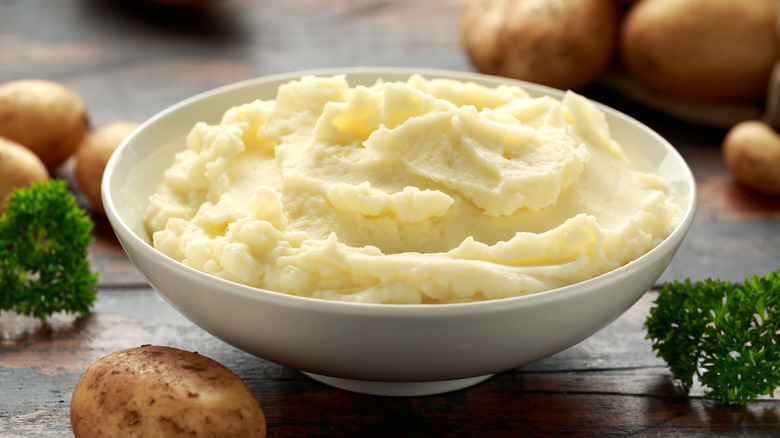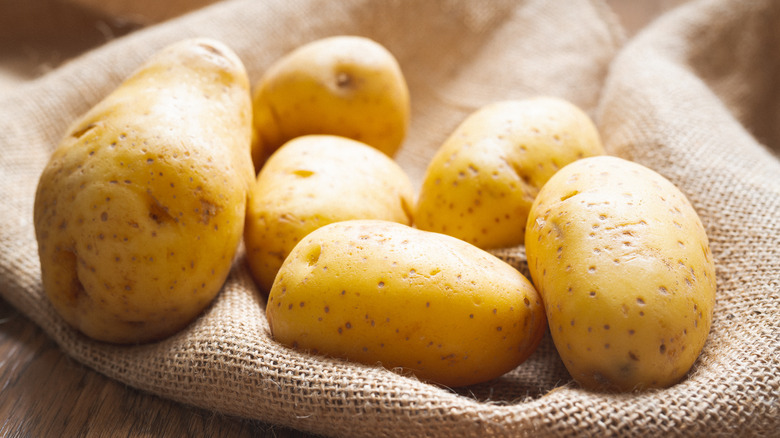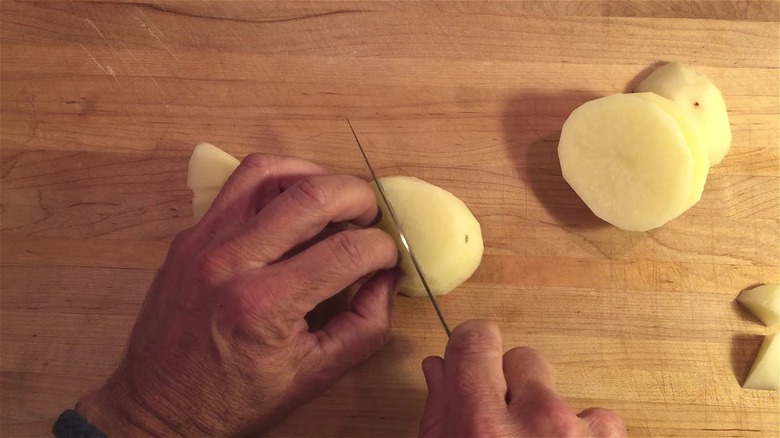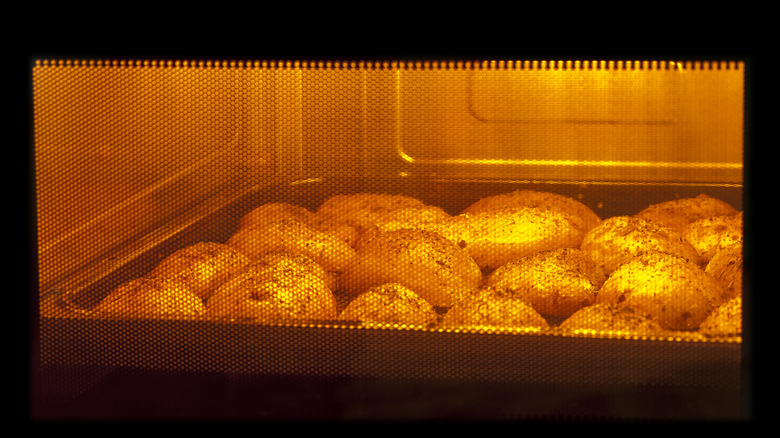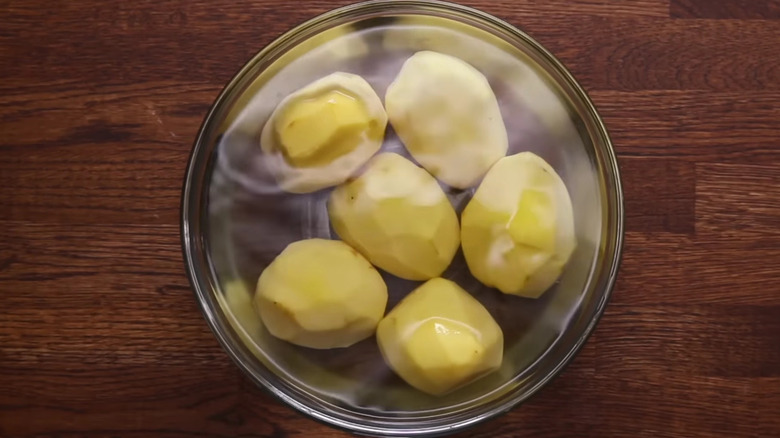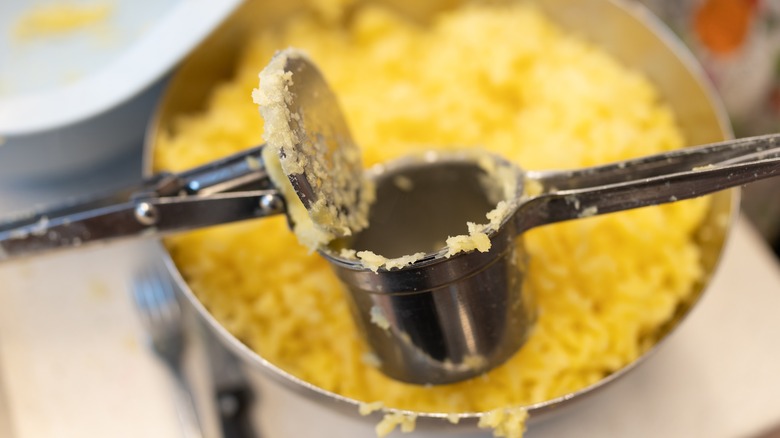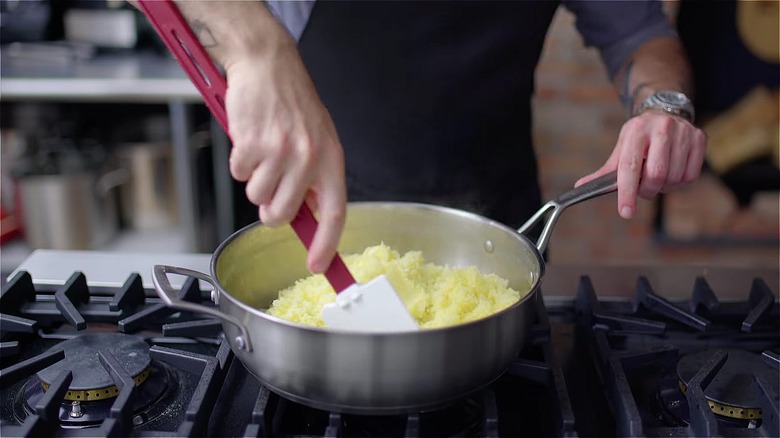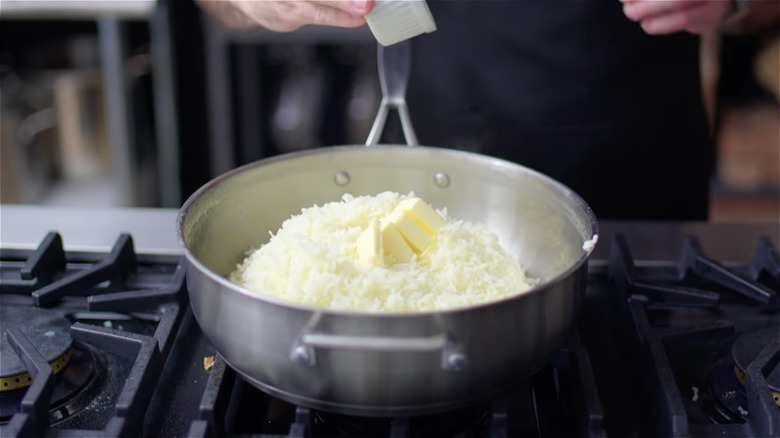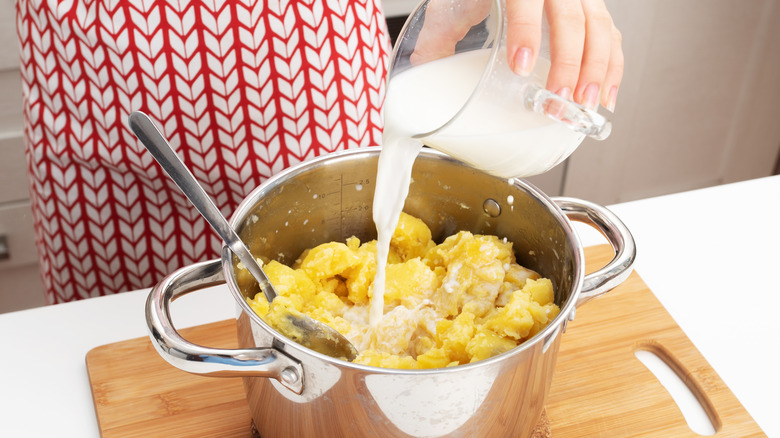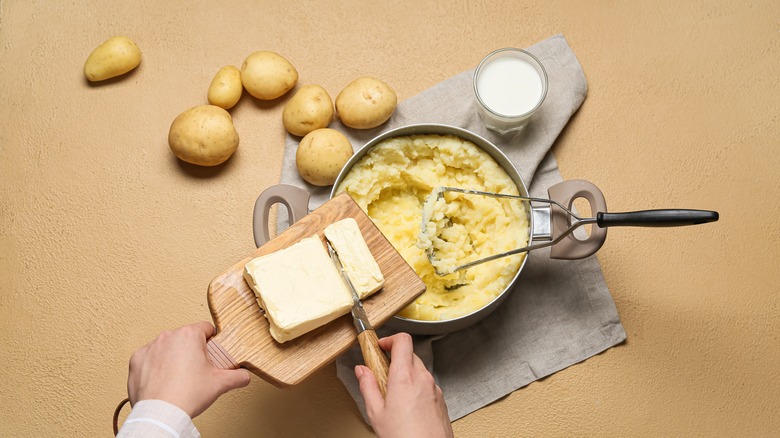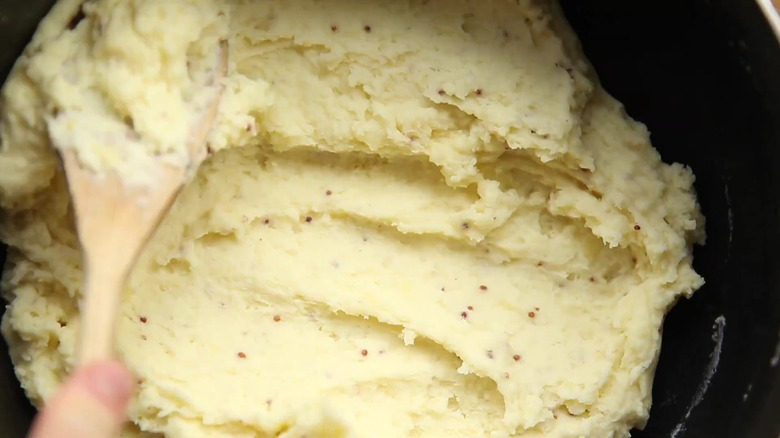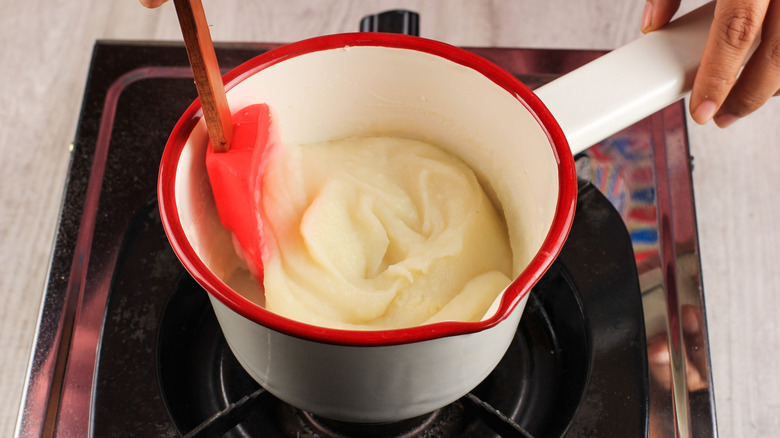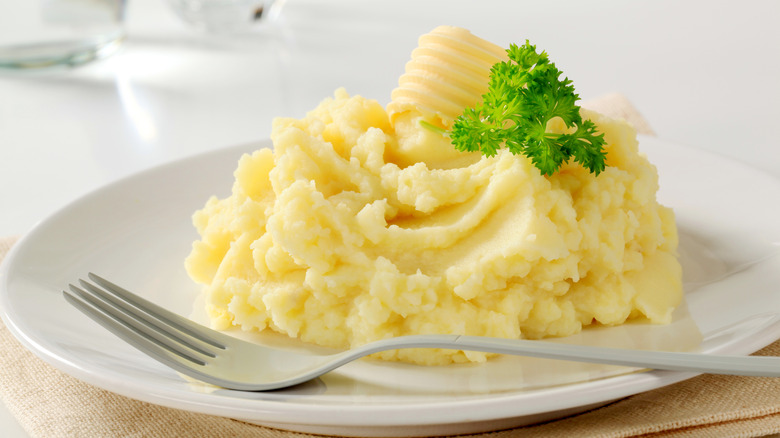12 Reasons Restaurant Mashed Potatoes Taste Better Than Homemade
Few dishes are as comforting or as versatile as mashed potatoes. Resultingly, the side is one of the most popular foods in the United States; a recent YouGov survey saw it rank third behind french fries and hamburgers. As with these other popular foods, mashed potatoes are enjoyed both at home and in restaurants across the U.S.
Simple recipes are the ones that reveal a cook's skill. For this reason, mashed potatoes that are served in restaurants often taste much better than those made at home. What's more, they often have a creamier texture and more striking appearance.
Given that mashed potatoes are so simple to make, it's almost baffling that a chef's version of the dish can differ so much from the gloopy heap of lumpy potatoes served by many home cooks. This vast difference arises from several decisions made throughout the cooking process. In other words, there are many reasons why restaurant mashed potatoes taste better than homemade.
1. Restaurants use the right variety of potatoes
The first step all restaurants take in making mashed potatoes is sourcing the correct variety of potatoes. Generally, potatoes can be split into three different groups: waxy potatoes, starchy potatoes, and all-rounders. Waxy potatoes have a low starch content and high moisture content which ensures they hold their shape during cooking. While this is convenient in some instances, it is of less use when making traditional mashed potatoes. Instead, most chefs prefer to use starchy potatoes because their flesh softens and collapses during cooking.
Not all starchy potatoes are created equal and each restaurant will have its own preferred variety. This comes down to what type of mashed potato the restaurant wants to serve. Those looking for denser mashed potatoes will likely use Yukon Gold potatoes, whereas restaurants aiming for a lighter mashed potato prefer Russet Burbank potatoes. In contrast to this careful selection, many home cooks use whatever potato is to hand. Unfortunately, using non-specialist potatoes means the finished dish will never taste as good as those served in restaurants.
Home cooks also struggle to create mashed potatoes fit for fine dining. That's because chefs like Thomas Keller use waxy potatoes as they absorb the most amount of fat and therefore flavor. Home cooks are advised against using waxy potatoes because the extra effort to remove lumps often results in them becoming overworked and pasty.
2. Chefs prepare the potatoes uniformly
Most people cut up their potatoes before boiling them as it increases the potato's surface area to volume ratio, reducing its cooking time. Home cooks do not pay much attention to how they cut their potatoes, believing that, as the pieces are mashed before they are served, uniformity does not matter. Unfortunately, haphazard cutting means that the potatoes are cut into an array of pieces that are both too small and too irregular.
Cutting the potato into very small pieces means the potatoes absorb a great deal of water when they are boiled. This means less butter and milk or cream can be absorbed by the potatoes, making them blander and texturally loose. Uniformity is also important because all pieces of potato will be cooked together for the same duration. As large pieces take longer to cook through than smaller pieces, any discrepancy in size will result in uneven cooking and ultimately a lumpy mash, flecked with undercooked pieces of potato.
Chefs carefully chop their potatoes as they understand how a potato is cut affects how it cooks and mashes. In a video posted to YouTube, Alton Brown demonstrated his technique. It involves cutting a potato into rounds and then each round into eighths. To ensure each piece is uniform, Brown even discards the end of his potatoes. While an extreme example, careful preparation such as Brown's is one of the reasons why restaurant mashed potatoes are much smoother and taste better than homemade versions.
3. Alternative cooking methods are used
The standard way of preparing mashed potatoes is to peel, chop, and then boil them until they are soft before mashing. While this makes satisfactory mashed potatoes, some restaurants have turned to alternative cooking methods to improve the dish. Among the most common is steaming.
Steaming pieces of potato over boiling water prevents them from absorbing too much moisture. As previously mentioned, this allows the potato to absorb more butter and milk or cream, resulting in a more flavorful dish. As a nice aside, the potato also retains more of its nutrients when steamed. Some people even claim steamed potatoes have a stronger flavor than boiled ones.
A handful of chefs including Oliver Marlowe prefer to eschew water altogether. Instead, Marlowe opts to bake his potatoes skin and all before removing and mashing the soft, cooked innards. He described the process to The Mirror: "Take it out of the oven, and scrape out all the potato, which at that stage will be nice and dry. Then you can add as much of the good stuff like butter, cream, or milk into that and it will absorb more and more."
4. Excess potato starch is removed
Although many chefs use starchy potatoes, they understand that too much starch can be a bad thing. That's because a large amount of starch results in a denser, creamier version of mashed potatoes, called pomme purée. Lighter, fluffier mashed potato can only be made if the amount of starch is controlled. Thankfully, there are several ways cooks can influence starch levels.
As starch is released when plant cells are broken, a gentler mashing technique — like using a potato ricer — will limit the amount of starch released. Aside from selecting less starchy potatoes and using gentler mashing techniques, rinsing and soaking the potatoes prior to cooking also reduces their starch levels. If all these steps are taken, fluffy mashed potatoes are the result.
Cooks that want dense and creamy mashed potatoes can prevent starch loss by cooking potatoes with the skins still on. A violent mashing technique, such as blending or whisking will also boost the release of starch. Joël Robuchon famously used both tricks to create an incredibly decadent version of pomme purée.
Home cooks must decide what style of mashed potato they desire and consequently adopt the correct techniques to either limit or encourage the release of starch. Failure to do so results in mashed potato that is neither decadently creamy nor light and airy. Instead, the dish is an anti-climatic intermediary.
5. Restaurant kitchens use an array of equipment
The majority of home kitchens have a few pieces of well-worn equipment that must be relied on for any number of culinary tasks. Professional kitchens, on the other hand, are often stocked with a plethora of specialist equipment that's been designed with one specific task in mind.
In terms of mashed potatoes, a lack of equipment can steer home cooks toward less optimal preparation methods. For example, a cook in a poorly equipped home kitchen must use a fork when trying to make fluffy potatoes instead of the preferred potato ricer. Unfortunately, the finished dish will be all the poorer for concessions such as these.
Professional chefs face no such challenges. They can prepare mashed potatoes as they see fit thanks to an array of specially designed equipment. Chef Olli Dabbous told The Guardian that he makes mashed potatoes by forcing them through a fine drum sieve to make them extra smooth. Joël Robuchon went one further, using both a potato ricer and whisk to achieve his decadent take on the side.
6. The potatoes are dried before mashing
It is a fact that the more butter, milk, and cream absorbed by the mashed potatoes, the more flavorful the final dish will be. As we have seen, boiling and steaming remain two of the most popular cooking methods when it comes to making mashed potatoes. Both these methods result in moisture entering the potato's flesh. This limits the potato's ability to absorb the flavorful fats. The average home cook pays little heed to this but professional chefs, who are being paid to create excellent food, try to reduce the potato's moisture content before adding butter, milk, or cream.
The solution chefs have come up with is a simple one: dry out the cooked potatoes before adding the fats. Joël Robuchon dried his riced onions in a saucepan over a low flame. Ex-chef and food writer Sasha Marx suggests placing the cooked potatoes on a baking sheet that's placed in a low-temperature oven. Both methods result in the potato absorbing more butter, milk, and cream and developing a superior flavor. As an additional bonus, losing excess moisture also prevents the mashed potatoes from becoming loose and watery.
7. Professional chefs use a lot of fat and salt
There are no two ways about it: fat and salt make food taste better. Chefs know this; they frequently add large quantities of butter and salt to many dishes when cooking, including mashed potatoes. Home cooks, on the other hand, do not as they are more concerned with striking a balance between flavor and the healthiness of the dish. The result is a large discrepancy in fat and salt usage between the two camps as chef Keith Sarasin highlighted to HuffPost: "The amount of salt — and butter — used in the restaurant world is much higher than the average home cook is used to."
Like all other foods, mashed potatoes benefit from the inclusion of fat and salt. Joël Robuchon took this knowledge to the logical extreme, creating a mashed potato recipe that called for a two-to-one ratio of potatoes to butter. The resulting dish was heavenly albeit extremely rich.
Most chefs do not go to Robuchon's extremes. Raymond Blanc, for example, only uses around two and a half ounces of butter for every two pounds of potatoes although extra fat is incorporated through the addition of whole milk.
8. Dairy is kept at the right temperature
A chef's knowledge and skill is the difference between an excellent dish and a mediocre one. Mashed potatoes are no different; a chef's understanding of the ingredients and cooking process causes them to take steps that home cooks would not even think about. One example of this is controlling the temperature of the dairy before it is added to the mashed potatoes.
Most home cooks will take their butter and milk and chuck it straight into the pot regardless of whether the milk is cold or the butter melted. This is a mistake as milk and cream should always be heated before adding to mashed potatoes and butter should only be added while cold and solid.
The reason for warming cream and milk before adding it is simple: the potatoes absorb them more readily when they are warm. Easier absorption means cooks don't have to work the potatoes much to get the ingredients incorporated. This ensures minimal amounts of starch are released during mashing.
Chefs only add cold, solid butter to mashed potatoes because this ensures that both the fat and milk solids are absorbed evenly by the potatoes. Melting the butter prior to adding will see it split. When this melted butter is poured over, some parts of the mashed potato will receive milk solids and other parts the melted fat. This will affect both the texture and taste of the final dish.
9. Chefs know what order to add the ingredients in
Even if home cooks use the same ingredients in the same proportions as professional chefs, their mashed potatoes remain inferior. While technique and skill play a role, the mashed potatoes are also different because home cooks add ingredients in a less-than-optimal order.
The most drastic example of how ingredient order can affect the final taste of mashed potatoes is found when adding dairy. During this crucial stage, the butter must be added first, a fact that chefs like Diane Morgan are well aware of. If the butter is added after the milk, less fat is absorbed and the potatoes taste markedly less buttery and rich.
When other ingredients are added to mashed potatoes can also have an effect on the final dish. Salt is a prime example of this. Most chefs instinctively season food throughout the cooking process. This gives the salt time to penetrate the food, adequately seasoning all of it. On the other hand, home cooks often only salt dishes towards the end of the cooking process. As with other dishes, mashed potatoes will taste worse if only seasoned just prior to serving.
10. Restaurant chefs add flavorings
The idea of adding ingredients other than salt, butter, milk, and cream to mashed potatoes is a foreign one for most home cooks. Restaurant chefs, however, find upgrading the dependable side with flavorful ingredients almost second nature. This is demonstrated by a trio of mashed potato recipes from Gordon Ramsay. One is flavored with three different mustards: English, Dijon, and wholegrain. Another is flavored with truffle oil and truffle paste. The last has garlic and several herbs added.
Other chefs including Andrew Rudd prefer to use spices to add a kick to their mashed potatoes. Rudd told RSVP Live that he likes to incorporate nutmeg into the dish during the festive period. Daniel Clifford, a chef at Midsummer House, introduces more flavor to the dish through the addition of reblochon cheese.
All of these takes on mashed potato carry much more flavor than the plain iterations served by people at home. This is an obvious, albeit common, reason why restaurant mashed potatoes taste much better than homemade versions of the dish.
11. The mashed potatoes are made ahead of time
It is not practical for professional restaurants to make mashed potatoes to order. It simply takes too much time and effort. Instead, professional cooks make mashed potatoes in bulk, prior to service. During service, the potatoes are simply heated and portioned as the orders come in. If done properly, these mashed potatoes are no worse than those made fresh.
Ex-chef Daniel Gritzer explained that professional chefs do not add cream or milk to mashed potatoes when making them ahead of time. These ingredients are added just before the potatoes are served; a portion of mashed potatoes is added to the hot cream or milk and combined. By heating the cream or milk before adding the potatoes the dish is rapidly brought up to temperature. It also ensures that the mashed potatoes achieve a texture almost identical to those that have been freshly made.
The speed and ease with which pre-made mashed potatoes can be reheated and brought to the table — with no discernible drop in quality — makes them superior to the freshly made mashed potatoes served by home cooks. While the make-ahead method is a practice beloved by professional chefs, home cooks can also adopt it. The technique is especially suited for large celebrations such as Christmas and Thanksgiving.
12. The mashed potatoes are garnished
As with most dishes served in professional restaurants, mashed potatoes usually come to the table topped with a garnish. This garnish can be as simple as a handful of chopped chives. In terms of herbs, parsley is a popular option.
Professional chefs garnish mashed potatoes for two reasons. Firstly, it boosts the visual appeal of the dish by adding color and a bit of variety. Secondly, garnishes add an extra layer of flavor to the dish. Both of these are equally important; visual appeal should not come at the expense of flavor and vice versa.
Although a valued part of the cooking process, adding garnishes remains a divisive practice. After all, what one person views as attractive another might see as over the top or pretentious. There are plenty of noted individuals, including food critic Jay Rayner, who revile just about all garnishes. However, it is still thought that home cooks looking to elevate their mashed potatoes to a restaurant standard use a garnish. It should just be added with care.
